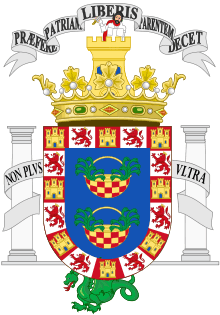Conquest of Melilla
The Conquest of Melilla occurred in September 1497, when a fleet sent by the Duke of Medina Sidonia (the precise involvement of the Catholic Monarchs in the operation is a moot point in historiography) seized the north African city of Melilla.[1]
During the 15th century the mediterranean cities of the Sultanate of Fez (Melilla among them) fell in decadence in opposition to cities located in the Atlantic facade, which concentrated most of the economic activity.[2] By the end of the 15th century, the port of Melilla, that had been often disputed between the rulers of Fez and Tlemcen, was nearly abandoned.[3]
Plans for the conquest occurred as soon as the Fall of Granada in 1492. Spanish captains Lezcano and Lorenzo Zafra visited the coast of Northern Africa to identify possible locations for the Spanish to overtake, and Melilla was identified as a prime candidate.[4] Melilla was, however, in the Portuguese zone of influence under the terms of the 1479 Treaty of Alcáçovaz.[4] At Tordesillas in 1494, King John II of Portugal, the Portuguese ruler agreed to make an exception and permitted the Spanish to attempt the conquest of Melilla.[4]
The duke sent Pedro Estopiñán who conquered the city virtually without a fight in 1497, as internal conflicts had depleted it of troops, and its defenses were weakened.[4] The Wattasid ruler Muhammad al-Shaykh sent a detachment of cavalrymen to retake control of the city, but they were repulsed by the guns of the Spanish ships.[4]
See also
Notes
- Bravo Nieto 1990, pp. 15; 24.
- Bravo Nieto 1990, pp. 21-22.
- Castrillo Márquez 2000, p. 172.
- A history of the Maghrib in the Islamic period by Jamil M. Abun-Nasr p.146
Bibliography
- Bravo Nieto, Antonio (1990). "La ocupación de Melilla en 1497 y las relaciones entre los Reyes Católicos y el duque de Medina Sidonia". Aldaba. Melilla: Universidad Nacional de Educación a Distancia: 15–38. ISSN 0213-7925.
- Castrillo Márquez, Rafaela (2000). "Melilla bajo los Medina Sidonia, a través de la documentación existente en la Biblioteca Real de Madrid". Anaquel de Estudios Árabes. Madrid: Universidad Complutense de Madrid. 11. ISSN 1130-3964.
